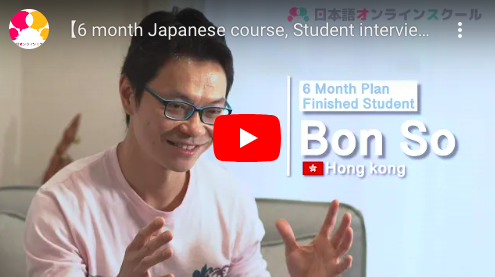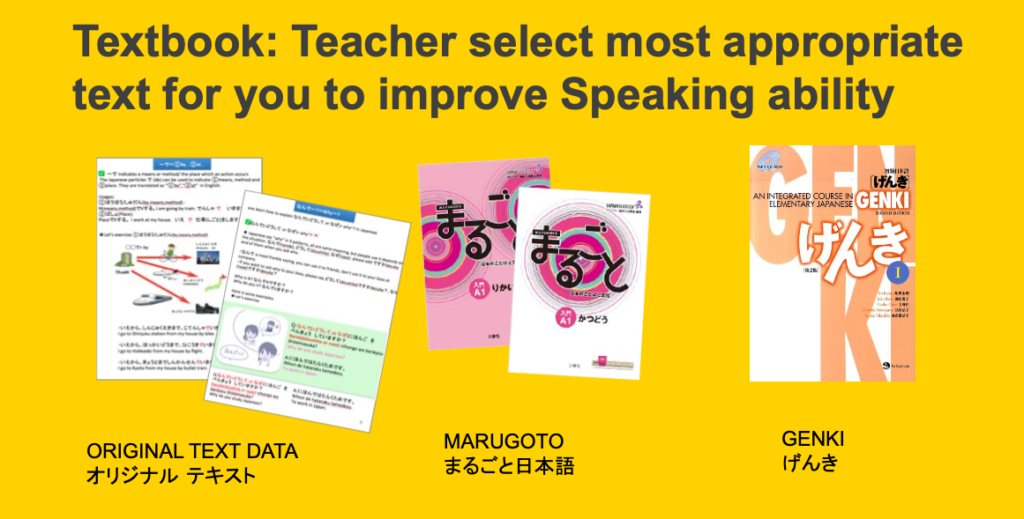Tips for More Effective Studying
Nihongo Online School > Tips for More Effective Studying > [Study Plan with Bon-san]6 Month Plan with 50 Online Lessons Completed
[Study Plan with Bon-san]6 Month Plan with 50 Online Lessons Completed

2024/04/10
Hi, this is teacher Yuki of Nihongo Online School. Today, we introduce study plan for one of our students Bon -san living in Tokyo,Japan studying Japanese.

Qualifications
Teacher Yuki
Completed 420-hour Japanese language teacher training course
I started my career at a Japanese language school in Bolivia and have been teaching at Nihongo online school since 2019.
Experience
I myself am interested in foreign cultures and languages, so I find it very stimulating to meet students from different backgrounds and share lesson time with them.
I am always happy when students are able to express themselves well in the Japanese they have just learned, and I feel happy to be teaching.
We reviewed, 1. Trial lesson 2. Feedback about Japanese level 3. Study plan 4. Study approach 5. Improvement for this blog.
Contents
●Summary
Nationality: HongKong
Age: 30
Occupation: Software Engineer
Reason for learning Japanese:
I work at a Japanese company, but I often use English, so I don’t have many opportunities to practice Japanese.So, I decided to study Japanese because I wanted to be able to communicate with Japanese people well.
●Trial Lesson Feedback
【Level : JLPT N5 (Level 1 in our level chart)】
※Based on the OPI level criteria, we will evaluate your conversational ability on a scale of 10. If you want to more about conversation level criteria, please check this blog.
・Listening : He can listen if he is asked questions slowly using simple words.
・Speaking : He can speak using simple sentence patterns such as “A is B”. But he cannot conjugate verbs.
・Reading : He can read Hiragana and Katakana accurately.
・Although he knows most of the commonly used Japanese kanji, they are often used with different meanings than in Chinese, and there are many misunderstandings.
※we will evaluate your Japanese ability in terms of Reading, Speaking, Listening aspects.
●Learning Plan Enrollment Course: 50 hours Course
He often tries to understand Japanese based on English grammar, and it takes him some time to understand expressions that are difficult to translate into English or are unique to Japanese.
Regarding the grammar, he asks questions one by one with skepticism and tries to understand by adding his own interpretation. Corresponding to this, He will be able to solidify his knowledge of Japanese, so we’ll take our time and give detailed explanations.
Also, he often chats about the day’s events and weekend plans, but he often ends up speaking only English, so I change the sentences into Japanese and add key phrases. I try to create more opportunities to speak Japanese, such as asking questions related to the topic of the text, etc. And I write and leave messages in the chat so he could always remember it.
●Learning Approach
Teaching materials: Original text, Minna no Nihongo

Class frequency: 2 times/week (50 minutes)
How to proceed with the class:
① Vocabulary and grammar
Learn using texts. In the episode to check new vocabulary, we talked about things like predicting the meaning of new words by connecting them with words he already knew, and where he had actually heard them in everyday conversation. While expanding the information, we aim to gain input.
② Speaking
For about 10 minutes at the beginning of each class, we have free conversation and talk about today’s date, day of the week, recent events, and this week’s plans. He often ends up speaking in English, so we work together to correct the sentences into Japanese as appropriate.
③Listening
Ask questions using the sentence patterns he have learned so far.Start with a few questions at the beginning of the class, and during the class, we make time to ask questions and answer them such as ”Do you think so?’”or “What do you think about it, Bon?”’ according to the content of the teaching material.
④Writing (Homework)
As for writing, It wasn’t seem to really need for it based on his needs, so we didn’t particularly practice during class. For homework, have students create sentences using a sentence pattern practice book.
⑤ Reading (Homework)
Once He have mastered the N5 level sentence patterns,practice reading and understanding long sentences using the reading material on the Minna’s Japanese Summary Questions page.
●Achievement 【 Level : JLPT N4 (Level 3 in our level chart)】
① Vocabulary and grammar
Reached N4 level. In particular, at the N5 level, we spent time learning the te form, nai form, ta form, and plain form, and even in conversations, we used phrases such as “~ています、~てください、~てはいけません、~なければなりません、~なくてもいいです、~ないでください、~たり、~たり”.
② Speaking
N5+ level. He is now able to express what he wants to say using the sentence patterns he knows. Also he’s able to express complex expressions that could only be expressed in English better in Japanese.
③ Listening
N4 level. If the questions use the sentence patterns studied at N4 level, He can answer what he hears at normal speed.
④Reading
N4 level. He was able to correctly answer the Q&A on the reading material on the Minna no Japanese summary questions page, which was written using the sentence patterns I learned at the N4 level.
Overall
He was a complete beginner, having never studied Japanese other than hiragana, katakana, kanji, and simple greetings, but eventually improved to the N4 level. During class, he made sure to thoroughly review their grammar through question-and-answer sessions, and actively used new vocabulary and grammar to output their results.
There were many times when he compared English and Japanese and had trouble understanding them, but I think he was able to put together what he already knew and come up with his own interpretations, so he was able to grasp some aspects of it. His vocabulary increased, and he was able to solve questions about the various expressions he heard in their daily lives in class, and make the expressions his own. We will continue to support his work and life in Japan!

Qualifications
Teacher Yuki
Completed 420-hour Japanese language teacher training course
I started my career at a Japanese language school in Bolivia and have been teaching at Nihongo online school since 2019.
Experience
I myself am interested in foreign cultures and languages, so I find it very stimulating to meet students from different backgrounds and share lesson time with them.
I am always happy when students are able to express themselves well in the Japanese they have just learned, and I feel happy to be teaching.

